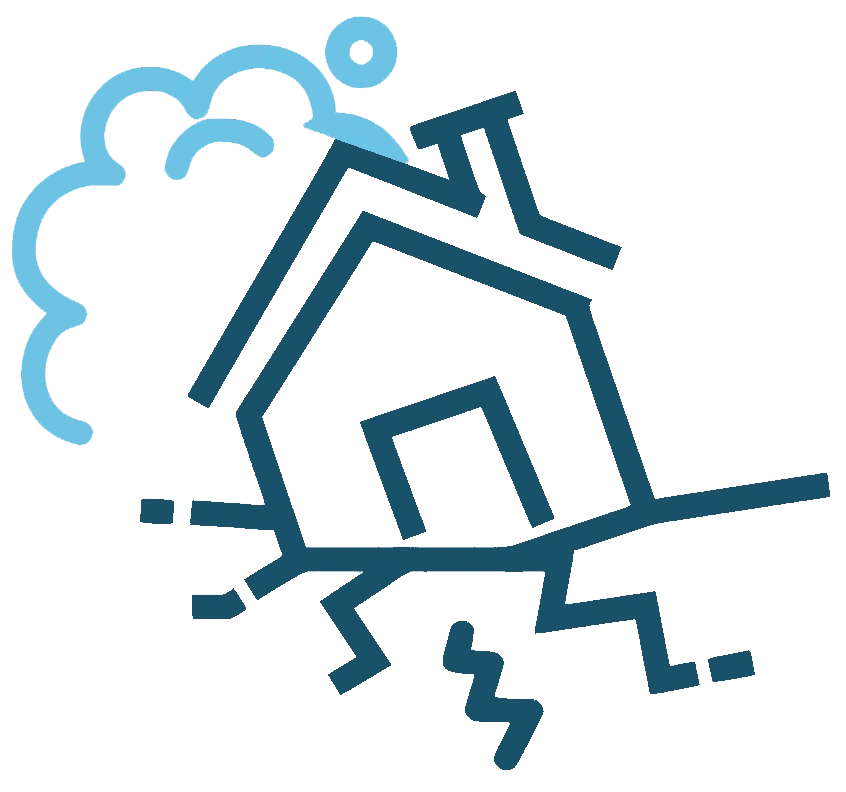Looking to sell your property fast but not sure who to trust? Complete our contact form
The Ultimate Guide:
Subsidence is where unstable ground starts affecting the structure of your home.
It’s indeed an intimidating situation.
It can have serious implications if you’re selling a house with a subsidence history.
You might suspect subsidence if you’re seeing large cracks on your inside and outside walls.
Left unchecked, subsidence can lead to major collapse.
But selling a house with subsidence history doesn’t have to be difficult.
Want to hear why we recommend My Homebuyers above everyone else?
We have independently investigated all the best cash home buyers in the UK.
We ranked them based on their cash offers, reliability, customer service and 15 more metrics.
And we discovered that ‘My Homebuyers’ are superior in every regard to all other companies.
My Homebuyers will give you the best genuine cash offer, without contracts and without any fees.
While other companies will try to lock you into a contract which is rarely in your benefit. Even if they claim they don’t have contracts, the truth is, they do. And they’ll force you to sign it.
Click the button below to see exactly why we recommend My Homebuyers as your best option.
And how you can use the free Safe Connect™ programme to get VIP treatment from them.
Here are the main options you have when selling a house with subsidence history.
You can address the issue yourself by hiring a structural engineer.
You can also put it on the market and try to find a buyer prepared to do the work.
You can use a fast home buying company and let them coordinate everything.
In this guide, we’ll explore these three and all other possible options in depth.
Read until the end to find out how you can eliminate all the bureaucracy and sell your house fast no matter how bad the subsidence history is.
Let’s dive in.
You might’ve noticed cracks here are there in your property.
They don’t always mean subsidence.
They can be a sign of less problematic things like a crack in the plaster. New builds often have these as a sign of ‘settling’.
Here are 7 signs you might have subsidence in your home:
None of these things are definite signs by themselves. The only way to know for sure is to have an inspection.
You can contact a structural engineer or subsidence specialist by yourself.
But your home insurer is usually the one to arrange a subsidence survey.
It’s best to start there, as the costs of the specialist might be covered by your insurance.
Subsidence happens when the ground underneath your house is unstable.
Unstable ground means the walls and foundations of your house can shift and sink.
A number of things can affect the stability of the ground.

Houses that have none of these issues might still have subsidence.
Rules about building bigger, more stable foundations were not brought in until the late 1800s (around 150 years ago).
But there are plenty of houses in England much older than this.
If your house is very old, it may have been underpinned in more recent decades.
But there are still some houses that rest on small, shallow foundations. These may well be at risk of subsidence.
Subsidence absolutely does not mean your house is doomed forever.
There are a lot of ways it can be addressed. It’s also quite rare to need huge underpinning works that cost tens of thousands of pounds. The fix might be quicker than you think.
Let’s look at some of the options for underpinning, and the estimated costs.
This is where builders dig boxes underneath the foundations and fill them with concrete.
This essentially builds a new foundation under the existing one.
Because this is a relatively simple form of labour, it’s not as expensive as you might think. Checkatrade gives an estimated cost of £375 per meter.
Naturally, the cost will depend on the amount of foundation that needs to be reinforced.
Unfortunately, the bill for very big properties with complex issues may be three or four times that.
If unstable soil is the culprit, it can be stabilized with injections of resin.
A mixture of glue and hardener is pumped into small holes in the foundation.
The fluid then expands to fill cracks and solidify the earth underneath the house.
This process averages £550 per square metre.
Beam and base is one of the more advanced underpinning techniques.
It’s also more expensive at an average of £700 per square metre.
It’s usually used to address foundations that are too small or too weak.
Structural engineers build concrete ‘bases’ where needed.
They then use a concrete beam to either support or replace the existing footing.
The beam then shifts the load to the concrete bases.
Naturally, you don’t need to decide on the method yourself.
An engineer will be able to tell you which will be most effective.
The overall cost will depend on how bad the subsidence is.
It will also be affected by the size of your house, and the amount of redecorating needed afterwards.
Houses with more floors need more structural support, so this will be a factor in cost too.
You’ll be relieved to hear that the answer is almost always yes.
As we mentioned in the intro, your buildings insurer should be the first person you contact with subsidence issues.
Once you’ve made a subsidence claim, they’ll help you arrange an engineer visit.
The engineer will advise both you and your insurer on the best course of action.
The time frame between assessment and repair can vary.
If it’s a quick fix they’ll arrange repairs shortly after the visit.
If it’s a bigger problem they may need to monitor the house over a period of time.
Bear in mind you’ll likely have to pay an excess.
This is the portion of repair work you agree to pay for when making a subsidence claim. How much this will be, depends on your policy.
Most buildings insurance excesses are in the region of £1,000.
If you’re selling a house with a subsidence history, you might be surprised at what people are willing to take on.
Some buyers are very prepared to do major works, especially if they’re making an investment purchase.
It might even be that you can find a buyer who is prepared to knock down all or part of the house.
You’ll be most likely to find this type of buyer if you’re in a particularly desirable location.

Or if there is value in your land (e.g. acreage, paddocks, agricultural uses, equestrian features, etc).
Unfortunately, mortgage lenders can present a problem.
Many mortgage lenders refuse to lend on a house with subsidence or even a subsidence history.
This issue can be avoided altogether if you’re lucky enough to secure a cash buyer.
Property developers and professional landlords often have access to cash.
These are the types of buyers your estate agent should be targeting if you’re selling a house with subsidence.
Using home buying services is another workaround. Home buying companies always buy with cash.
This means no mortgage needed, and no red tape to work around with mortgage lenders.
So you’ve found an interested buyer. What are the chances you’ll get the offer you’re looking for?
Let’s say you’ve had the subsidence fully repaired, inspected, and certified.
You can expect to achieve a market value offer, similar to any other house on your street.
That said, there may be some hesitation on your buyer’s part if subsidence works have been done in the past.
They might try to reduce their offer based on this. Your estate agent will help distil your buyer’s fears, and negotiate a price that works for you.
As we discussed in Section 3, there may be major expense involved in doing the repairs yourself. So you might be considering trying to sell the house as it is.
The answer to whether subsidence affects value is – unfortunately – a resounding yes. It’s arguably the biggest problem you can face with a house.
If the cost of repairing it is £50,000, your buyers will expect £50,000 off the asking price.
Their mortgage lender may also hit them with a much higher rate.
This is another cost they might try to knock off the asking price.
When selling a house, you have a legal responsibility to disclose certain things.
When you’ve secured a buyer, you’ll fill out a TA6 form (which you can view in full here). This will ask for information on things like:
There’s not a question about subsidence on the TA6 form.
But your buyer’s solicitor will likely find out when they submit searches.
These are queries your buyer’s solicitor submits to the local council.
They show lots of data about the local area, bylaws, and land conditions.
Their solicitor will also send you lots of queries that you must answer honestly in writing.
Most buyers will also have a survey of some kind.
Even if you do leave certain bits out, it’s the surveyor’s job to find them.

Those buying an old or dilapidated house usually have a full structural survey.
This will reveal signs of subsidence in a heartbeat.
When you’re selling a house with a subsidence history, it’s best to be honest from the start.
Trying to hide things generally delays the process. It can also cause bad blood between you and your buyer.
Even if they’re okay with structural issues, many people will withdraw from a sale if they feel there is dishonesty involved.
Worse than this, if something comes up after the sale is complete that affects your buyers negatively, they might be able to sue for damages.
If it goes to court and it’s found you left out or fibbed about crucial information, you can be liable for tens of thousands of pounds in compensation.
We hope this guide has helped you understand more about selling a house with a subsidence history.
And we hope you’ll feel much more informed and empowered to arrange your house sale with this guidance in mind.
We’ll leave you with a handful of resources you can take action with today.
A guide on the average costs of subsidence repairs. Remember every house and situation is unique, so use these as a guideline only.
The TA6 form you’ll need to fill out once you’ve secured a buyer.
If you believe your subsidence was caused by mining activity, you can file a subsidence claim on the government website to cover the costs of the subsidence survey and repairs.
We want to help out as many people as possible. That’s why we created this comprehensive article.
If you are looking to sell your property, call us on 0333 242 2814 or message us through the live chat.
Depending on your preference and circumstances, we’ll connect you for free with one of our strictly vetted, ethical partners.
They will help you sell your property for the best offer you can realistically achieve.
They will take care of all of the legal processes and fees and you’ll get the cash straight into your bank account.
With our partners you can achieve a very fast sale or a slower one if you’re not pressed on time.
Faster sales usually yield a lesser price but they save you time.
It all depends on your circumstances and preference.
In this article, we explored selling a house with subsidence history and all the difficulties you might encounter along the way.
Subsidence occurs when the land underneath your property has irregularities which make it unstable.
Unstable ground means the walls and foundations of your house can shift, sink and even collapse.
That’s why it’s important to notify the buyers, surveyors and everyone involved in the sale of your property about its subsidence history.
And even though selling a house with subsidence history appears to be a difficult endeavour, it doesn’t have to be.
If you decide to use a quick home buying company, they will take care of everything and you can receive the money for your property in less than 7 days.
If you want to sell your house with subsidence history fast and without having to go through a lengthy legal process, using a cash home buyer might be your best option.
Of course, by choosing speed, you have to sacrifice a bit of your property’s selling price.
But that’s a very reasonable trade off for many people.
Therefore, if you don’t want to deal with your property’s subsidence history in any way, consider working with one of our strictly vetted house buying partners.
They will buy the house from you fast and you will won’t have to deal with any subsidence history issues, nor any other house-related issues at all.
More To Explore
The Definitive Guide:
How to Stop Your House From Being Repossessed
Read More >>
All-inclusive Guide:
Selling a Property After the Death of Parents
Read More >>